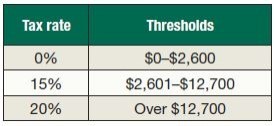Our Tuesday Tips for year-end planning continues this week with a few tax preparation tips, as it pertains to Trust Taxes, specifically Qualified Funeral Trusts. We also have included a few noteworthy 2018 tax updates.
- Investment Portfolio Rebalancing – Review Tax Lots to maximize Long-Term Capital Gains vs. Short-Term.
- Long-Term Capital Gains have favorable tax treatment unlike Short-Term Capital Gains.
- If you can manage to hold your assets for longer than a year, you can benefit from a reduced tax rate on your profits. For 2018, the long-term capital gains tax rates are 0, 15, and 20percent for most trusts. If your ordinary tax rate is already less than 15 percent, you could qualify forthe zero percent long-term capital gains rate. For high-income trusts, the capital gains rate could save as much as17.0 percent off the ordinary income rate.
- Long-Term Capital Gains have favorable tax treatment unlike Short-Term Capital Gains.
- Qualified Dividend Income – Determine what dividends are Qualified vs. Non-Qualified.
- Qualified dividends, as defined by theUnited StatesInternal Revenue Code, are ordinarydividendsthat meet specific criteria to be taxed at the lower long-termcapital gains tax raterather than at highertax ratefor a trust’sordinary income. The rates on qualified dividends range from 0% to 20%.
- To qualify for the qualified dividend rate, the trust must own the stock for a long enough time, generally 60 days for common stock and 90 days for preferred stock.
- To qualify for the qualified dividend rate, the dividend must also be paid by a corporation in the U.S. or with certain ties to the U.S.
- Qualified dividends, as defined by theUnited StatesInternal Revenue Code, are ordinarydividendsthat meet specific criteria to be taxed at the lower long-termcapital gains tax raterather than at highertax ratefor a trust’sordinary income. The rates on qualified dividends range from 0% to 20%.
- On Dec. 22, 2017, President Donald Trump signed into law P.L.115-97, known as the Tax Cuts and Jobs Act. Its many new provisions include noteworthy changes to the income taxation of trusts, most of which are effective for tax years 2018 through 2025.
- The law provides, for tax years 2018 through 2025, a new table under Sec. 1(j)(2)(E) of ordinary income tax rates and thresholds for trusts and estates (subject to adjustment for inflation for years after 2018) as shown in the chart below.
Ordinary income tax rates

- The law retains the preferential rates for qualified dividend andlong-termcapital gain income under Sec. 1(j)(5) but adjusts the thresholds as illustrated in the chart below.
Capital gains and qualified dividend rates

